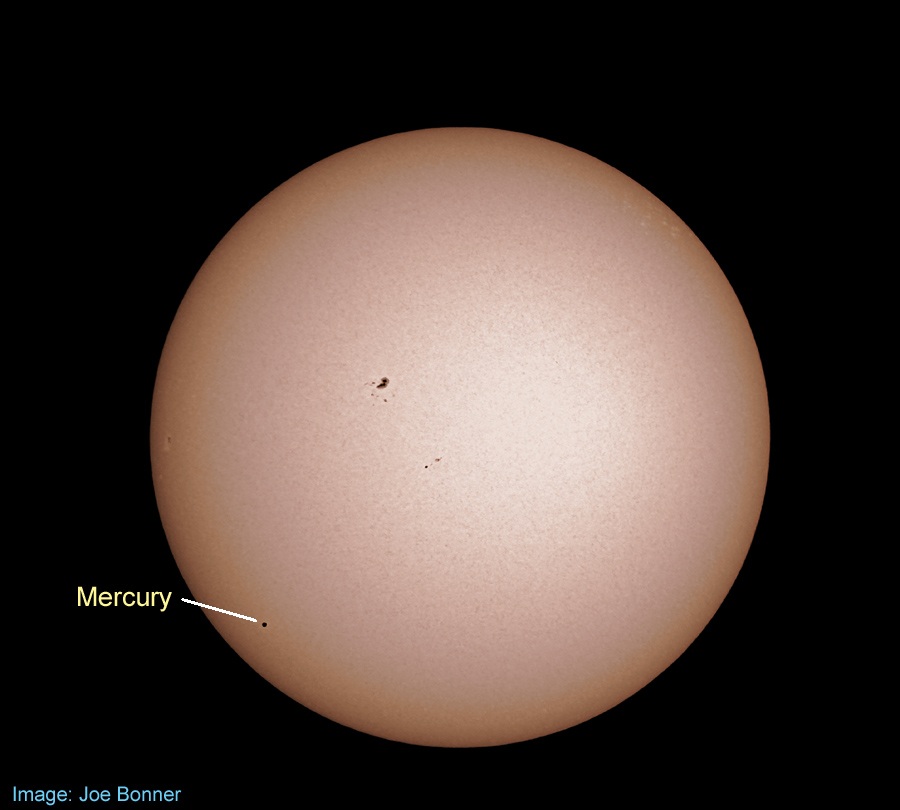The Transit of Mercury
For thousands of years, the naked eye planets have been observed as they slowly moved across the starry sky. The word planet comes from the Greek meaning “wanderer” and for good reason. Today’s telescope transforms these dots into detailed worlds such as the rings of Saturn, the polar caps on Mars and the four Galilean moons orbiting the banded clouds of Jupiter.
This month the planet Venus is coming out of the solar glare and climbing higher in the western sky while Jupiter is sinking closer to the horizon. Venus will be 1.4 degrees south of Jupiter on November 24 low in the west. A great digital moment comes four nights later when the slender 6% crescent moon is located one degree above Venus with Jupiter off to the right and appearing as “spooky eyes.”
Planets and moons reflect sunlight off surfaces and cloud tops but on rare occasions, we can see then in a different light – their dark side. Throughout our lives, we only have a handful of chances to witness a transit of Mercury and Venus across the Sun’s disk. Venus did this in 2004 and again in 2012 to only repeat in the years 2117 and 2125. Mercury, on the other hand, crosses more often and there have been nine transits since 1960 with the next one on November 11.

The Remembrance Day transit begins with first contact around 7:36 a.m. EST with the transit ending around 1:06 p.m. EST. The next Mercury transit will occur on November 13, 2032. Needless to say, you will need a solar filter to observe and photograph the event in safety but Mercury is tiny as seen in the image below. A transit is one of the methods astronomers use to detect exoplanets in other star systems. The Kepler Telescope imaged more than 150,000 stars every 30 minutes to detect minute dips in brightness as a planet crossed its parent star’s disk.
Joe Bonner captured the May 5, 2016 transit with his Meade 8" LX90, 0.65 focal reducer and a full aperture mylar filter. He used a Canon T2i set at ISO100 and took three 1/1000 second frames then stacked with Registax 5.
There are three meteor showers this month with very sparse zenithal hourly rates (ZHR). The South Taurid meteor shower peaks on November 6 with only 5 meteors seen per hour. Next, is the North Taurid meteor shower peaking on November 12 with also a low 5 meteors per hour rate and the Full Beaver Moon to contend with.
However, the Leonids will produce a bit more activity with a ZHR=10-15. It peaks on the morning of November 18 but is far from the meteor storm of 1933, 1966 and 1999. I remember the night of the 2001 shower when Earth passed through two debris fields on the same night. At one point we were at a ZHR=2,100. The parent comet 55P/Tempel-Tuttle measures only 3.6 kilometres across and returns in the year 2031 on its 33-year orbit around the sun to replenish dusty debris to hopefully produce another storm the following year or so. One of the most intense displays occurred in 1833 where hourly rates reached 140,000 or 40 per second.
Daylight Saving Time ends on November 3 at 2 a.m. as we set our clocks back an hour. New moon or lunation 1199 will occur on the 26th.
Until next month, clear skies everyone.
Gary Boyle
